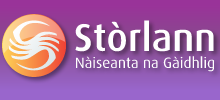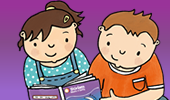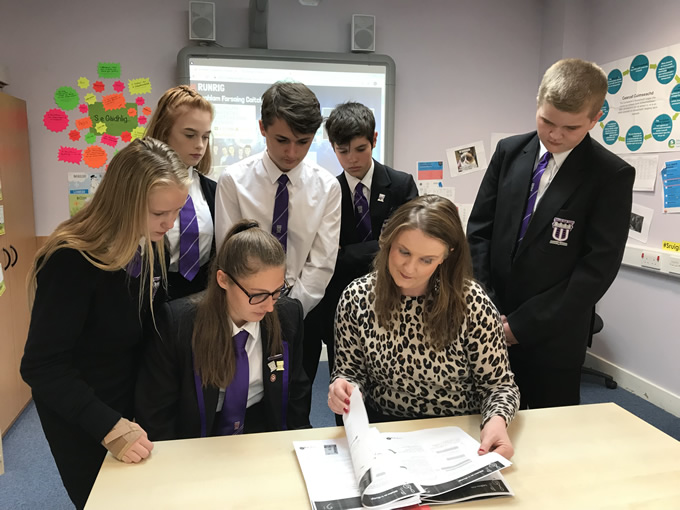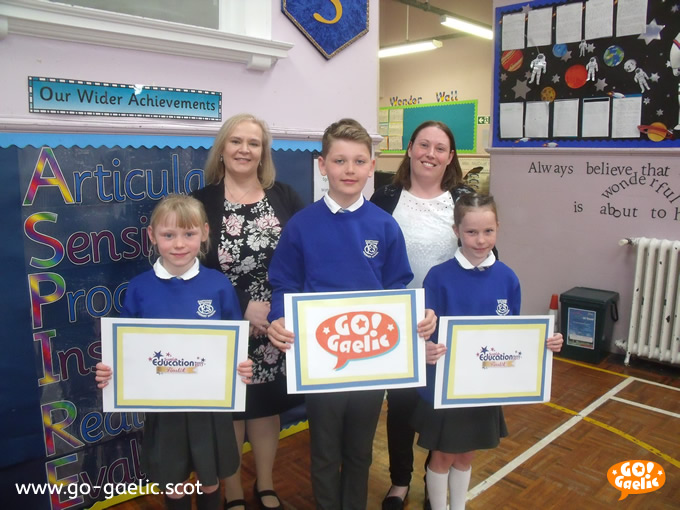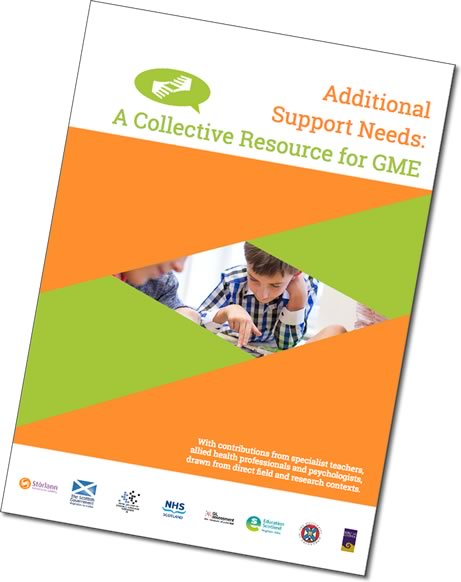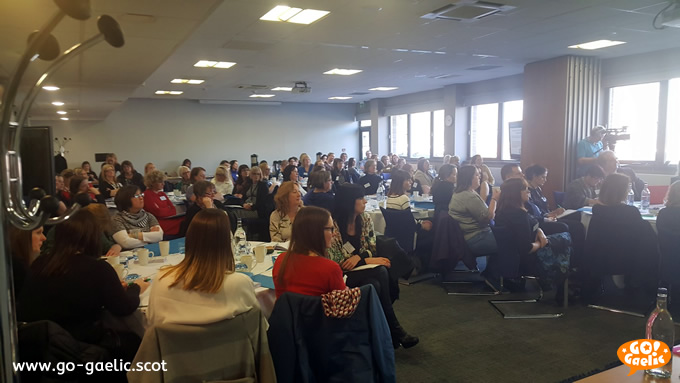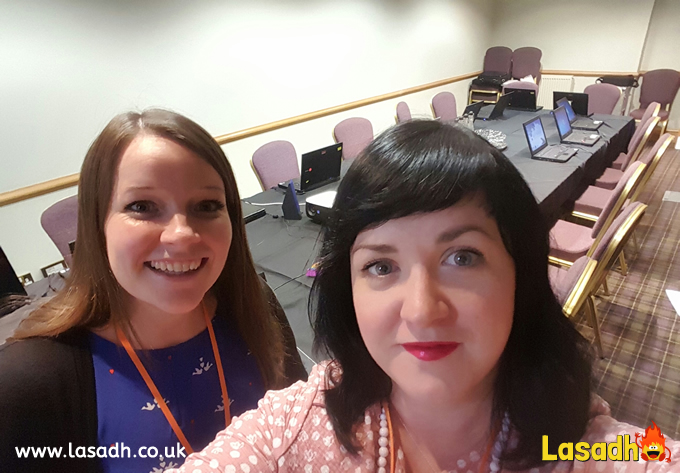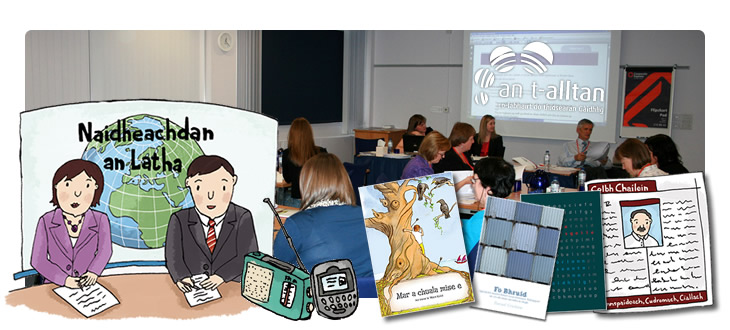
Naidheachdan

28 November 2018
Gaelic teachers encouraged to share resources via new website
A website for Gaelic teachers to share classroom resources has been created by Stòrlann Nàiseanta na Gàidhlig, the Gaelic educational resources organisation.
The website – www.storlann.co.uk/seo-sibh – is a straightforward facility where teachers can pool their resources, to save time and effort. Material can be uploaded and downloaded and teachers are being urged to share their resources with the site, so they can then be made available to others.
All resources that are uploaded will be quality assured by Stòrlann staff before they are shared for downloading, so teachers who make contributions can be reassured their vocabulary and grammar will be checked before being made publicly available. Stòrlann will also do any design work needed, to ensure all resources are presented in the best possible light.
The resources are split into sections – for early years, primary, secondary, parents and general resources – and teachers are being encouraged to contribute towards building a bank of material that can be accessed by Gaelic teachers working at all levels across the country.
Some of the Seo Sibh resources are also editable files, so they can be tailored to suit.
Teachers who submit their resources will be clearly credited for the work, although they can opt not to be publicly acknowledged, if they prefer.
Stòrlann have been receiving material from teachers for a while, and a facility for uploading resources has existed for a couple of years, but the Seo Sibh website has only recently gone live.
It also contains links to other sites, and to some of Stòrlann other material, but is mainly about providing a platform for sharing resources.
Neil Smith, Head of Development Services for Stòrlann, said the site had been created “to meet a need and respond to teacher feedback”. And he pledged that, as more and more resources are added, Stòrlann would keep developing it and increasing its functionality.
Seo Sibh is potentially “quite important for teachers” but he said that would depend on how much teachers used it. “We’ve put the facility there and it’s now up to teachers to use it. Some people are reluctant to share things but we would encourage them to share all their work because sometimes things they think are of little use would be of benefit to other teachers. There’s a bit of reluctance to share but it stops a lot of duplication of effort.”
Charlotte Mackay, a primary teacher at the Glasgow Gaelic School, is one of the teachers whose work is already available for download at Seo Sibh. And she was delighted to learn of the website’s existence, as she had lost the pen drive containing her original resources.
“That is great news. It’s actually really great news because I lost my USB stick that all that work was on. I’ll be quite happy to get that back. I will definitely send more stuff in. This is something we’ve been asking for for ages.”
Charlotte said Gaelic Medium Education did not have the same amount of resources as English Medium Education, so it made sense to pool resources. She added: “I like the idea that it’s being moderated as well, because a lot of people feel self-conscious about their work. This will make them a lot more willing to share resources.
“Quality assurance is great, because that will remove that barrier that teachers may feel self-conscious about having made a grammatical error or whatever.”
She described the file-sharing website as “invaluable”, adding. “If we get something that’s a template, we can adapt or change it.
“Sometimes you do feel you’re starting from scratch and it’s also about making the language standardised. Even for ourselves in the Gaelic school – and we’re a big school – one teacher will use one word for something and another teacher will use something else. “I’m away to look at it now…!”
Stòrlann Chief Executive Donald W Morrison said: “Sharing Gaelic resources through Seo Sibh is a wonderful idea that is easy to engage with.
“Gaelic culture and education is jam-packed with positive examples of collaborative consumption being put to good use. As the Gaelic education sector grows the potential for the sharing of learning resources is there to be used. With the creation of Seo Sibh, Stòrlann is pleased to harness technology for the furtherance of a collaborative practice that benefits the Gaelic learning sector by extending the pool of resources available for use in schools.
“A little time invested in sharing pays great dividends to all – picking up on a popular Gaelic proverb: ‘An làmh a bheir - an làmh a gheibh’ (the hand that gives - the hands that gets).’”
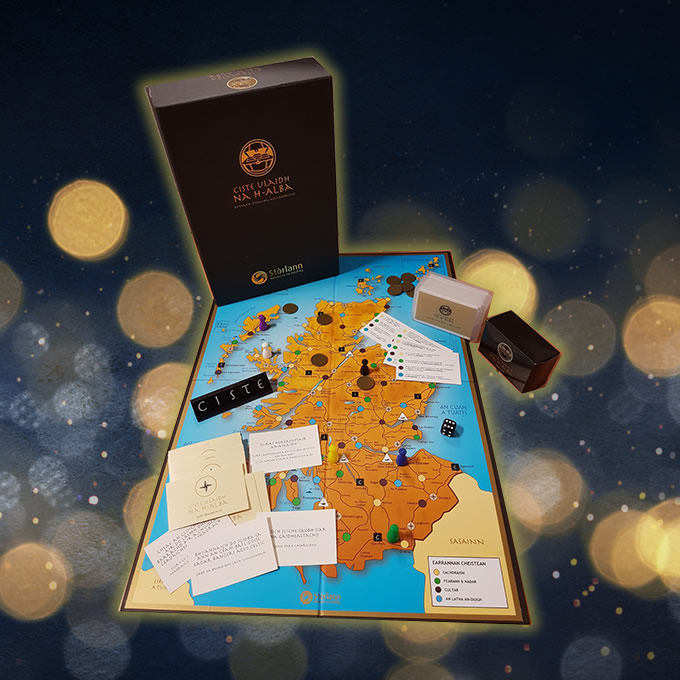
28 November 2018
Gaelic version of Scottish heritage board game on sale for Christmas
A Gaelic version of Scottish Quest, the popular board game about Scotland’s heritage, has gone on sale to the general public – and would be an ideal Christmas present for Gaelic-speaking families to enjoy during the cold, dark nights.
The game, Ciste Ulaidh na h-Alba, has been created by Gaelic educational resources organisation Stòrlann Nàiseanta na Gàidhlig and is available to buy from their online shop at https://www.storlann.co.uk/buth/.
It can also bought directly from Stòrlann by visiting their offices in the An Tosgan building on Seaforth Road in Stornoway or by phoning them on 01851 700880.
This Gaelic version of the game was officially launched a couple of years ago by Deputy First Minister John Swinney, but at that time was only available to schools. Most of the 500 sets produced in that first run went into schools involved in Gaelic Medium Education.
Now, however, Ciste has been put out on general release and Stòrlann are delighted that Gaelic-speaking families, whether fluent speakers or learners, will have the chance to buy a version of their own for the home.
Ciste — like the English version it is based on, Scottish Quest — is a heritage game with questions about land and nature, history, culture and contemporary Scotland.
The difference is that all the questions and place names in this version are in Gaelic.
The game is suitable for children from the age of eight up to adults and there are two sets of 1000 questions with every box – one set easier; the other more difficult – to make it suitable for as wide an age range as possible.
Stòrlann chief executive Donald Morrison is delighted the game is on sale in time for Christmas and believes it will be a great focus for family evenings during the winter.
“On a cold night, there's little that's better than gathering by the fireside with a board game. If you wish to have this family fun through Gaelic, ‘Ciste’ is the answer. Crack open the chest and join the fun on a Gaelic tour of Scotland.”
He added it was a “highly versatile learning tool” and an “ideal and fun way to use Gaelic with the family at home”.
Ciste Ulaidh na h-Alba is entirely in Gaelic which means players are introduced to a lot of vocabulary through the four categories of questions: eachdraidh (history), fearann agus nàdar (land and nature), cultar (culture) and an latha an-diugh (contemporary).
Ciste is Gaelic for ‘chest’ and the aim is to collect the letters C I S T E from their locations around the map of Scotland, which is depicted on the board. By following the directions on cards, players have to travel around the country, learning as they go.
The questions themselves are a mix of the original set, translated from Scottish Quest, and some new questions, added in to create more of a Highlands and Islands flavour. Extra place names have been added in too.
The in-house team at Stòrlann, and associated consultants, redeveloped the game. This included translation and redesign, as well as researching the additional questions.
Donald Morrison added: “One of the big advantages of knowing Gaelic is that you understand your place so much better. Scottish place names, for example, so often come from Gaelic and it is good to have a fun resource that highlights such ties. In play, Ciste will hopefully foster a greater appreciation and understanding of the links between Gaelic, the people and the land.”
ends
Pictures available for download via WeTransfer link.
For more information please contact:
Donald W Morrison, Chief Executive, Stòrlann — 01851 700880; dwmorrison@storlann.co.uk
Katie Laing, PR Consultant— 07825200110
16 October 2108
Mod launches for Gaelic flashcards app and Sorley MacLean poetry competition for schools
An app to support young learners with the acquisition of simple Gaelic phrases is being launched this week at the Royal National Mod in Dunoon.
The app, Abair Abairtean!, is being launched today (Tuesday, October 16) by Gaelic educational resources organisation Stòrlann Nàiseanta na Gàidhlig, which commissioned its development.
It will be followed tomorrow by another announcement from Stòrlann – this time about a poetry competition being run in partnership with Urras Shomhairle, The Sorley MacLean Trust.
The competition is to inspire a new generation of Gaelic poets and is open to all secondary school pupils. Stòrlann intends to use the winning entries in new classroom resources, as a further source of inspiration to young writers.
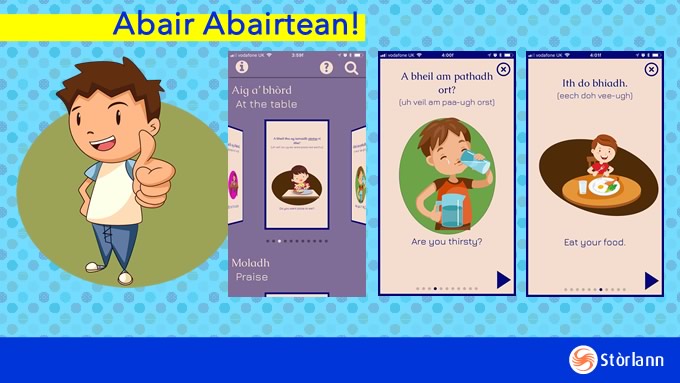
Abair Abairtean! App
Stòrlann’s first event, though, is the launch of Abair Abairtean!, which is available for download now on iTunes. It features 50 phrases suitable for situations around the house and outside.
The phrases are organised by categories such as ‘at the table’ and ‘praise’ and examples include ‘ith do bhiadh’ (eat your food) and ‘nighean mhath’ (good girl).
Abair Abairtean! is the app version of Storlann’s popular handheld Gaelic flashcards, which are available to buy direct from Stòrlann.
Both the app and the flashcards give the phonetic pronunciation alongside the Gaelic and English translations – and the app also has audio for the Gaelic, so users can hear how it should sound.
Shona MacLennan, Chief Executive of Bòrd na Gàidhlig, said: “We are delighted to see this new resource for children and parents. It is fun and easy to use, and since the words and phrases are on audio, it’ll provide great support to learners of Gaelic. As it is available on mobile phones and other devices, as well as being free, it is a very attractive resource.”
The handheld flashcards are available to buy for £5 from Storlann’s online shop – www.storlann.co.uk/buth/en/shop/ – or by phoning Storlann direct on 01851 700880.
Donald W Morrison, Chief Executive of Storlann Naiseanta na Gaidhlig, said the Mod Showcase at the Queen’s Hall in Dunoon was the natural place for launching the app and the competition.
The aim of Abair Abairtean!, he said, was to support young learners at home.
It is supported by Bòrd na Gàidhlig and aimed at the Early Years, and includes phrases that would typically be used in croileagan and at home.
“The app is for general use, to support Gaelic learning, although it is very much aimed at pre-school. A lot of parents who have children in Gaelic Medium Education and don’t have Gaelic themselves can use it for reinforcing Gaelic in the home.
“A significant number of learners compete at the Mod so it’s an appropriate place for us to launch the app and raise awareness of it.”
“It’s a really nice way to bridge the gap between home and school or pre-school croileagan, just by bringing the material that they would use in croileagan into the home as well, and it’s user friendly.
“For those who wish to buy the flashcards, they are available online.”
Writing Competition
Meanwhile, tomorrow (Wednesday), Stòrlann will announce the relaunch of a writing competition for second school pupils in partnership with Urras Shomhairle, The Sorley MacLean Trust.
The Farpais Bàrdachd Gàidhlig competition is in memory of the famous Gaelic poet and is for poems of any length, on any subject relating to a school course or the writer’s choice.
Entries will be split into three age groups – first and second year, third and fourth, fifth and sixth.
The Farpais Bàrdachd Gàidhlig competition, which Stòrlann is promoting along with Urras Shomhairle, is supported by the Glasgow Skye Association and the Gaelic Books Council.
A panel will judge the entries which have to be in by February 8, 2019.
Prizes are £100, £80 and £40 for each of the three categories, with prizes being a mix of Amazon vouchers and Gaelic book vouchers.
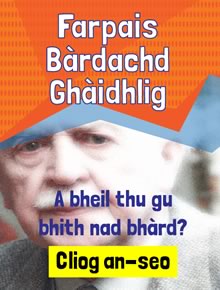
Hugh Dan MacLennan, Chairman of Urras Shomhairle, said: “The Trust is delighted to be re-launching the poetry competition in partnership with Stòrlann, and grateful to the Gaelic Books Council and the Glasgow Skye Association for their support.
“This is an extremely important initiative for the Trust and we would hope to be in a position to publish the work produced in due course.
“There could be no more appropriate field for us to be working in memory of the bard’s work and life than encouraging poetry within schools. We wish all the schools and pupils taking part every success in their endeavours.”
Donald W Morrison said the competition aims to encourage children to write “In a the midst of busy lives, writing requires encouragement. Stòrlann is happy to give a wee push for young people to get into the writing mode because, when they do write, we are aware that they come up with splendid work.
“We’ll use the prize-winners pieces as examples for their peers online.”
Stòrlann uses many pieces of literature from authors, poets and other writers in its Gaelic resources for the classroom – but young writers are always welcome.
“Young people appreciate writing from their own peers,” commented Donald W Morrison.
“It opens out a lot of possibilities, certainly in my mind, and does a lot to inspire people to try it out for themselves. This is the first year of the newly launched competition but, if it works, we’ll seek to continue it.”
01/10/18
Gaelic Medium Education promotional film previews at An t-Alltan 2018
Conference organisers also announce research into teachers’ aspirations on use of technology in class
The 10th annual conference for Gaelic education practitioners, which took place in Aviemore last week, has been hailed a great success.
Around 200 delegates from all over the country attended the conference, held in the MacDonald Aviemore Conference Centre last Wednesday and Thursday (September 26 and 27) and organised by Gaelic educational resources organisation Stòrlann Nàiseanta na Gàidhlig, with support from Bòrd na Gàidhlig and the Scottish Government.
Through a programme of talks and workshops, the conference provides delegates with an overview of current best practice and a look at new initiatives for teaching and learning. It caters for staff from the Early Years sector as well as primary and secondary schools.
This year, the conference had a focus that was very much on the whole learner journey through the Gaelic Medium Education system, right from the beginning with Cròileagan and play groups through to developing the young workforce.
A powerful new film which has been created to promote Gaelic Medium Education was shown for the first time at the conference. The film has been made by Fàs Foghlaim – Highland Council’s social media vehicle for promoting Gaelic education – and will be made available to the public later in the year but delegates got a welcome preview of it.
Entitled ‘Gaelic Medium Education – A New Perspective’, the film lasts eight minutes and features testimonies from GME parents and teachers as well as perspectives from leading bilingualism academic Professor Antonella Sorace, of the University of Edinburgh, and Tidelines singer and songwriter Robert Robertson, who came through GME himself.
With 90 per cent of connections in the brain being formed by the age of three, the role of Cròileagan and other Gaelic-speaking pre-school groups has long been recognised for their importance in getting learners started on their journey to bilingualism.
As such, the Early Years sector is seen as an important part of the Alltan conference and representatives from that sector said they gained a lot from this year’s event.
One development officer said afterwards: “The feeling was, from people attending, that they had learned lots of practical skills and strategies that they could then implement immediately in their groups and share with parents and children.
“The Step Wee Ceilidh workshop was a real highlight, using ceilidh dancing and the Gaelic language, and a hit with everyone. There were other practical, language-based activities that could be done outside in the environment, which added to the fun.”
The key, she said, for introducing Gaelic to the younger ones was to do it through activities that were fun, which is why the ‘Thig a Chluich’ (Come and Play) sessions were so successful.
“It has to be fun and it has to be simple, so that the children can pick up the language. That 0-3 stage is the first part of the jigsaw going into place.”
“They are hearing the language and picking it up without even realising it.”
Increased funding has gone into the Early Years sector in the past few years and interest from parents has increased too.
“So many people are interested now. There’s a growing number of parents and children wanting to learn Gaelic because of the benefits of bilingualism. There’s the links to songs, the culture, the language, their community… and I think people want to be part of something that’s really successful. There’s a growing demand for it, no doubt about it.”
That interest and demand will only increase when the Gaelic Medium Education promotional film becomes publicly available, scheduled to be before the school enrolment timetable.
It was also announced at the conference that Stòrlann will be setting up a task group to look at the use of technology in the classroom and teacher aspirations for that.
In his address to conference, Stòrlann Chief Executive Donald W Morrison said they would be setting up a task group to consider the future needs of education in the context of the digital agenda and the growing trend towards digital resources.
He said: “We can put laptops into classrooms and devices into the hands of pupils but we need to find out more about the aspirations of the teachers in terms of embedding the use of such resources within learner journeys and embedding the use of technology into teaching practice.”
The digital message was also delivered to the conference from opening speaker Kate Forbes, the Skye, Lochaber and Badenoch MSP who is the Minister for Public Finance and the Digital Economy.
Donald W Morrison said: “Kate Forbes’s speech was highly encouraging. She demonstrated a deep interest in developing Gaelic aspects of the digital agenda in forthcoming years and actually invited the delegates to open up dialogues with her, which is a highly positive development.”
The conference’s keynote speaker was Joan Mackay, Education Scotland Assistant Director, whose presentation on the second day was titled ‘Developing the Young Workforce IS the curriculum’.
Donald W Morrison added: “That was a really thought provoking and challenging address. It wasn’t overly specific; it was more of an informed glimpse of the future with a very clear challenge for teachers to engage. It was inspirational and set the tone for the day.”
Overall, he said, it was a successful event. “It was fab. We didn’t have any major glitches at all – it all went really smoothly. For me, the defining factor was the highly positive buzz that permeated the event. There was an extremely strong spirit of togetherness and common purpose and we have to thank all those who attended for that.”
For more information please contact:
Donald W Morrison, Chief Executive, Stòrlann — 01851 700880; dwmorrison@storlann.co.uk
Katie Laing, PR Consultant— 07825200110
Stòrlann launch Gaelic schools resource on Runrig
22/09/18
A NEW schools resource which celebrates the contribution Runrig have made to the Gaelic language and culture has been launched by Gaelic educational resources organisation Stòrlann Nàiseanta na Gàidhlig.
The unit is a significant addition to the Gaelic resource corpus and part of Stòrlann’s Fileanta suite of resources for fluent Gaelic speakers in secondary school, although it can also be used with some learner classes.
It became available to schools in August, a few days before the band played their farewell concerts at Stirling City Park, and it was back to Stirling for the official launch yesterday (Thursday, 19 September) at Wallace High School.
Like all Fileanta resources for Gaelic classes, the Runrig unit is available exclusively online and had been planned before the band announced their retirement. With appropriate timing, it celebrates “the huge contribution” they have made to the Gaelic language, culture, and education.
The unit includes the text of nine songs, for literary analysis; seven passages for close reading; a class project for young people to write a Gaelic song of their own; and two interviews – an old BBC interview with Seonaidh Beag, the man who inspired the song The Cutter, and another with founding Runrig member Calum MacDonald, which was recorded especially for Fileanta.
Acknowledging the significance of the new resource, Stòrlann Chief Executive Donald W Morrison said: “I very much wish to thank Wallace High School – in particular Gaelic teacher Alison Macrae – for hosting this launch, Stòrlann’s production and authoring teams and Runrig for their support and kindness.
“Stòrlann is delighted to acknowledge Runrig’s significant contribution to the regeneration and development of Gàidhlig language and culture. I consider this new piece of work to be wholly apposite, when one considers that the roots of Runrig lie in a time where Gàidhlig language development was finding a place in communities and on strategic public agendas.
“At that time some key emergent initiatives such as Fir Chlis, Cinema Sgìre, the Gaelic pre-school movement, Historical Societies, the Bilingual Project, and Comunn na Gàidhlig were forming. Coupled to this, Gaelic Medium Education, in Glasgow, Inverness and Lewis, along with increased Gàidhlig outputs on radio and television worked to place Gàidhlig language and culture in the field of Scottish consciousness.
“Wallace High School, being at the heart of Scotland or Alba, as we prefer to call it, is the obvious choice for the launch of the unit Runrig – whilst the band’s last dance was recently danced on Stirling’s soil, Stòrlann is confident that the Runrig legacy, like Gàidhlig, will – in all its amazing forms – live on.”
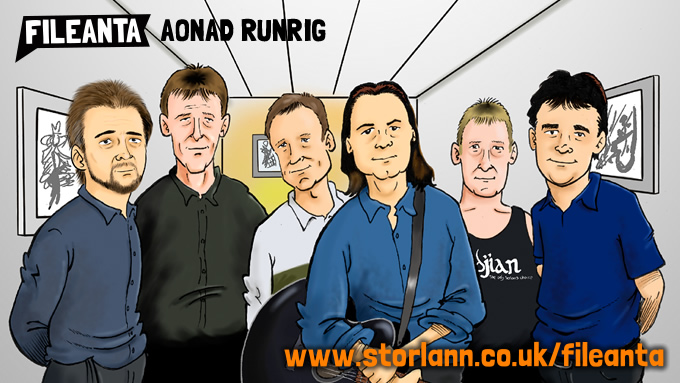
The unit can be found online at www.storlann.co.uk/fileanta/leughadh-litreachas and has been downloaded nearly 350 times, which suggests it has been an instant hit with educators as that is more than four times the number of secondary schools in Scotland involved in teaching Gaelic.
Mairi Macritchie, Stòrlann Project Officer for secondary school resources, developed the unit along with another teacher, Eoghan Stewart, and said: “It definitely looks like it’s been well received.”
Mairi – pictured showing the unit to Wallace High School pupils – said the idea for the Runrig unit had come from teachers themselves, via a panel who advise Stòrlann about where there might be gaps in school resources and what to develop.
“We had just thought there was a gap in the market, as it were. There was a feeling that something on Runrig was missing and we thought we shouldn’t really restrict it to one age group – why not write a unit that’s suitable for all?
“The aim was to have a unit that commemorated and focused on their work and it so happened that it was coming to a close when Runrig announced their retirement as well. “That was a bit of coincidence.”
The reasons for choosing Runrig as a topic were simple. “They had just contributed so much to the Gaelic language and Gaelic culture.
“Their farewell concerts were evidence of that, as three generations of Gaels were there. The songs are a huge part of Gaelic history and the history of the Gaelic language.”
Although Fileanta units are normally geared towards fluent Gaelic classes at National 4 and National 5 level, even Higher, there are elements of the Runrig unit that could be used with children at any stage in secondary school, depending on the extent of their Gaelic.
The idea was to avoid restricting the unit to a particular age group and to allow flexibility.
“We want it to be used with a range of classes and across a range of levels,” said Mairi. “Why restrict Runrig to a Higher class? Why not start it in S1 and give them a taste of it? The unit doesn’t have to be used all at one time. They can pick and choose from it.”
As well as the songs, close reading passages, creative writing piece and the interviews, there is also a timeline of the band, illustrations by Des Campbell, and various external links.
Mairi said the unit “ticks all the boxes” in terms of Curriculum for Excellence.
She pointed out that Calum MacDonald had been very helpful in the development of the unit and it was good to be able to pay tribute, with this unit, to Runrig.
“As a Gaelic speaker and a teacher, I think their contribution is invaluable,” she said.
“I can’t see that we’ll ever have that again. They worked hard and fought for Gaelic at a time when there wasn’t a lot of support for Gaelic. I think Gaelic is seen as being rather trendy and fashionable now but it wasn’t then. It was a fight for them. They didn’t have the support at the start that they ended up with. It wasn’t as easy.”
Of the unit itself, Mairi said: “It’s definitely something that the secondary teachers will find useful. I think it’s a sentimental piece of work as well because we didn’t have anything like this up until now on Runrig, just the collection of their work.
“I think the timing is just perfect as well because a lot of the children and young people who were at the concert will have a new or renewed appreciation in the band and this unit will help them to link school with their extra-curricular life.”
Fileanta was first launched in 2015 and is generally aimed at National 4 and 5, although some elements of all the units are also suitable for Higher.
The work of creating resources and uploading them to the website — www.storlann.co.uk/fileanta — is continual. Mairi said: “Fileanta is a collection of resources. We are adding to it. It’s ongoing.
“It’s covering all aspects of Creation and Production, Analysis and Evaluation, and the literature focus as well. If teachers are wanting something for Higher, we try to aim a resource at the higher end of National 5.”
The norm is for a lot of the resources to be transferrable across year groups and abilities, even down to S1 and S2. As well as providing the texts, the unit also makes suggestions for accompanying class work, based on the curriculum requirements, and provide teachers’ notes for further support.
Mairi said the response to Fileanta in general had been “very positive”.
'We support you' - Stòrlann message to parents considering GME
29/01/18
Gaelic educational resources organisation Stòrlann Naiseanta na Gàidhlig is sending a strong message of support and encouragement to parents considering Gaelic Medium Education for their child or children, as the dates for enrolment approach.
Stòrlann provides an impressive range of teaching materials for Gaelic education settings across Scotland - and is today stressing that it also supports parents who may not be able to speak Gaelic them-selves and be concerned about how to support their child.
The main sources of support for parents are online: the gaelic4parents.com website and its Homework Help section, where parents can have live online chats with teachers and get answers to whatever Gaelic-related query they have.
Acknowledging parents' possible concerns as they come to decision time about Gaelic Medium Education, Stòrlann chief executive Donald W Morrison said: "As a parent of three children that successfully completed Gaelic Medium Education, I would say… go for it.
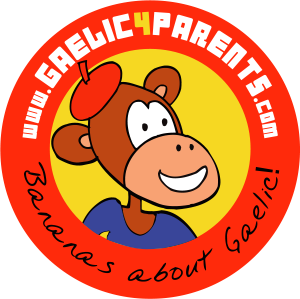
The whole system has been in place now for over 30 years and is working very effectively.
It's designed to support parents, both Gaelic speaking and non-Gaelic speaking.
"The risk is in not going for it because the advantages to Gaelic Medium Education are many.
"The cultural, environmental and academic aspects of Gaelic work to strengthen a sense of identity.
A further benefit comes in the form of the enhanced job opportunities that come thereafter and the added bonus is it's fun being able to function in two or three languages."
The gaelic4parents.com website is widely recognised as an "invaluable service to parents and children being taught Gaelic through GME throughout Scotland".
These were the words of Falkirk East MSP Angus MacDonald when he tabled a motion in the Scottish Parliament to congratulate it on its 10th anniversary back in 2016.
One of the main attractions of gaelic4parents.com is its online collection of hundreds of audio books, including the Storyworld books which children have to read for homework.
If a parent is unable to read it or wanting to check pronunciation, the sound files are available at the touch of a button.
Audio books are available from other ranges too, such as the Gaelic Bookbug scheme, and co-edition 'hits', such as Acair's An Gruffalo.
In total, audio books were played 40,568 times on gaelic4parents in the last year.
The website is for all parents and children interested and involved in Gaelic education.
As well as audio books, there are online games, songs, stories and more - all designed, as Stòrlann says, "to help you enjoy the experience of learning Gaelic, whatever your age or ability".
It is divided into sections by age and stage, into 0-3 years, 3-5 years, P1-4 and P5-7.
There are activities for each age group, with the 'read aloud' sections being the main ones used for the primary school stages, as this is where the school audio books are located.
For the youngest groups, the online resources include 'listen and sing' sections, flashcards and pictures to print off and colour in - all part of the support being given by Stòrlann as children of nursery age set out on their Gaelic journey.
One of the key features of the website, though, is the online chat service Homework Help, where parents can get direct help from a qualified and experienced teacher.
It operates during the school term, from Monday to Thursday between 5pm and 7pm, and is manned by two teachers: Inge Birnie in Aberlour and Anne Marie Henderson in Lewis.
It works as a live chat where parents simply click on a button to ask for help.
As it says on the website, this is "a very easy solution" for parents who worry about being able to support their child or children with Gaelic homework.
Megan Macdonald, who lives in Lewis, has two daughters in Gaelic Medium Education and feels the support available on the website has been their safety net.
She said: "I couldn't put the girls in Gaelic if it wasn't for this.
It would be impossible because I have no words. It's just brilliant, especially by the time they get to P3 because their words are a wee bit more difficult.
"It wasn't a decision we took lightly. I thought, can I manage? Will I be able to do their homework?
I honestly couldn't have done it without gaelic4parents."
Donald W Morrison added: "Homework Help blows away the barrier of 'I can't provide support for my wee one'.
The sound files are really important too as a means of topping up the Gaelic language inputs that children receive in school."
The gaelic4parents support has a wider online reach too, with pages on Facebook and Twitter Gaelic4Parents.
The Facebook page has become a mini community in its own right, with more than 4,300 likes and an average weekly reach of 10,000.
Its word list posts regularly go viral, too.
The International Women's Day word list attracted nearly 40,000 page views, with the next most popular topics being Christmas, Winter and Halloween.
It also functions as an informal version of Homework Help as the Stòrlann staff who run it will do their best to answer queries if parents have a problem outwith the live chat times for Homework Help - and Facebook rates the page as being "very responsive to messages".
Donald W Morrison said: "As an online community, the Gaelic4Parents Facebook site is popular and growing.
It's all part of the support we give to parents and the support parents give to one another.
One of Stòrlann's key roles is to support parents into becoming confident of Gaelic Education.
If parents enrol their child in Gaelic Education, and we very much hope that they do, they are not making an error - they are making a very wise choice."
Double nomination at Gaelic Awards for teachers’ website ‘Lasadh’
27 October 2017
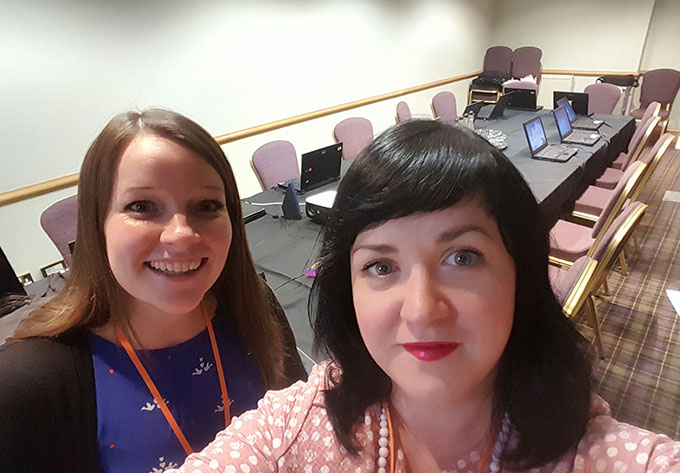
A website of resources for Gaelic Medium Education, run by two primary school teachers from Skye, has been shortlisted for a Scottish Gaelic Award for the second year running.
Lasadh is managed by staff at Stòrlann Nàiseanta na Gàidhlig and led by Gwen Culbertson and Mairi Macdonald, pictured above (Mairi is on the left), who both teach in Sleat Primary School (Bun-sgoil Shleite).
Lasadh is up for the Innovation in Education Award in the Daily Record’s Scottish Gaelic Awards, as it was last year, but is also nominated in the Learner Award category this year.
The awards, sponsored by Bòrd na Gàidhlig, will be held in the Grand Central Hotel in Glasgow on November 15 and aim to “reward all aspects of our Gaelic culture, education and language” and “highlight the excellent work undertaken to maintain growth and heritage”.
Lasadh is an online, digital and interactive resource for primary school pupils and teachers, created several years ago by Gwen and Mairi who had realised there was a shortage of language-related resources for Gaelic Medium Education (GME).
Found online at www.lasadh.co.uk, the website focuses on literacy activities and provides a range of resources for use in the classroom or at home and for individual use or group work.
There are many downloads which can be edited as required and the number of available downloads, digital games and other resources is growing all the time.
Recent additions to the website include spelling games, modelled on the ‘look, say, cover, write and check’ system used in schools, as well as jigsaws for the early years.
Use of the website’s resources has been increasing across Scotland. To support this demand, the Stòrlann team including Project Officer Sarah MacEachan, who is based in Uist, have delivered training sessions on Lasadh via video link to teachers on the mainland.
Another new development is that Gwen and Mairi have been seconded onto Lasadh since August for a day a week, thanks to support from Bòrd na Gàidhlig via the Gaelic Language Act Implementation Fund (GLAIF). The money means Stòrlann can fund the necessary class cover for Gwen and Mairi. Previously, the pair were working on Lasadh in their own time.
Gwen said: “The day a week each out of class for this year means that we can have a clear focus for development of materials and dedicated time to research and create them. Up until now it has been quite a juggling act with my young family of three and teaching full time, trying to fit it all in.
“Our secondment is only newly established, however thus far it has provided us with much needed opportunities to work together with Stòrlann to meet, discuss and plan the road ahead for Lasadh.”
All GME teachers are warmly invited to contribute their own resources for possible inclusion in Lasadh using a page on the site https://www.lasadh.co.uk/cuir-stuth-thugainn/
Stòrlann Project Officer Sarah MacEeachan explained how that page works. Teachers can upload files to various collections — primary school, high school, etc. Once the resources have been checked by Stòrlann they will then be uploaded for widespread use, either via Lasadh or the main Stòrlann website, www.storlann.co.uk.
Sarah said: “It’s for teachers to send materials in and we can proof them. We’ll quality assure materials and then they can be made available for other teachers.”
Sarah, whose other projects including the popular www.gaelic4parents.com website, warmly welcomed the news that Lasadh was again up for an award.
She said: “I was delighted to get the nomination, pleased that they’re recognising Lasadh as something valuable. We’re pleased to be nominated for the second year in a row and looking forward to the grand ceremony in Glasgow.”
Teacher Mairi said: “It’s a great feeling to be nominated again. It’s great to get good feedback on the project and it is an exciting project to be part of.
“The website and project have been growing over the years. More and more resources are being created and becoming available online. Digital games have become more available and now that Gwen and I have a day a week to work on the project, we hope it will continue to grow and resources will be available quicker and there will be a greater volume available.
“We are getting great feedback from teacher all over the country. This is the only online, accessible resource for Gaelic Medium teachers. They would like to see more resources over the curriculum so that’s something we are hoping to develop with Stòrlann in the future.”
Gwen added: “The response from teachers online and at our workshops has been very positive. This additional time allows us, with support from Stòrlann and their design team at Lumberjack Digital, to address and follow their ideas and further develop Gaelic Medium literacy resources.
“We both hope to attend the award ceremony and are very much looking forward to it. We are not entirely sure who might have nominated us, but Lasadh is very grateful. Fingers crossed for Lasadh on the night!”
In its nomination, Lasadh was described as a “fantastic and much-needed Gaelic Medium language resource”, with resources for reading, writing, talking and listening which were “high quality, easy to use, fun and have filled many of the gaps we had in language resources”.
It added: “They (Gwen and Mairi) are open to suggestions too. They know the struggles that GME teachers have because they are class teachers and resources are made to support us.
“This award would say thank you from all of us for all their hard work and give them the recognition that they deserve.”
30 August 2017
Gaelic ‘bear hunting’ kids are internet sensations
YouTube film of Glasgow schoolchildren nears 2.2million views
A group of primary school children from the east end of Glasgow have become internet sensations after their Gaelic musical version of ‘Going on a Bear Hunt’ went viral on YouTube.
Views of the film, which features youngsters from Caledonia Primary enacting the story in their school grounds in Baillieston, have climbed dramatically to nearly 2.2 million.
The film, made with the help of the Grounds for Learning charity, is just under five minutes long and shows the pupils from P1 and 2 ‘hunting’ for a bear. Dressed in oilskins and wellies, they go splashing through the mud and creeping through concrete tunnels, while they sing the words to Tha Sinn a’ Dol a Shireadh Mathan, a Gaelic version of the kids classic tale by Michael Rosen.
The story was shortened slightly and put to the tune of Drunken Sailor by the then depute head of Caledonia Primary, Jackie Mullen. Jackie, who now works with Stòrlann as a Gaelic trainer, is also a member of the band Folky MacFolk Face.
The film was made by a media crew working for Grounds for Learning back in 2013, when Jackie was teaching full-time and teaching Gaelic to the pupils at Baillieston.
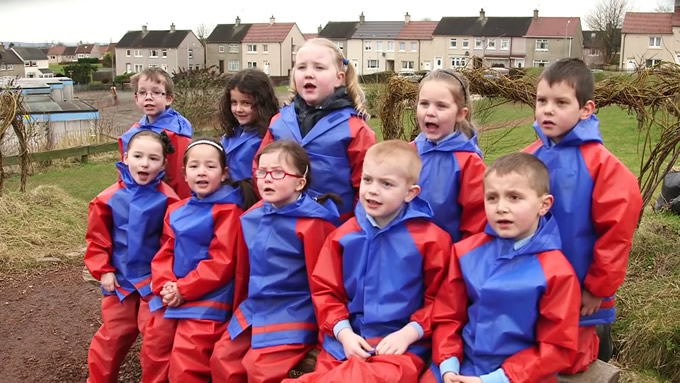
She had been looking for some stories and songs to bring the lessons to life and chose Tha Sinn a’ Dol a Shireadh Mathan, which had been published by Stòrlann.
The film was then shown at the annual Grounds for Learning conference on outdoor learning as an example of how teachers could use their school grounds for lessons.
The charity put it on YouTube but recently it began gathering an amazing number of hits. When it passed a million views in June, Grounds for Learning shared it again on their Facebook page, saying: “We have a hit on our hands! Watch, enjoy and share…” At that stage, it was getting between 40,000 and 60,000 hits a day.
The comments on YouTube show that people are watching it from far and wide. One music teacher from Iceland said: “This is absolutely wonderful! I can't stop smiling (the terrible bear!) and I really look forward to ‘playing’ this book with my Icelandic pre-schoolers… It would be nice to make an Icelandic version of it.”
Another woman said: “Wow, this is so cool. My daughter was randomly watching it and now she knows the whole song and watches it every day. We don't even live in Scotland, we live in Leicester…”
Jackie said: “Honestly, it’s incredible. I had no idea when I rejigged the script that it would end up this internet phenomenon that it’s been. Over two million is just incredible.
“When we made it we had no idea who would be watching it but somebody is. It’ll be really interesting to find out who all these people are. I’d say it’ll be at three million before we know it which is great for the language because it’s out there, big scale.”
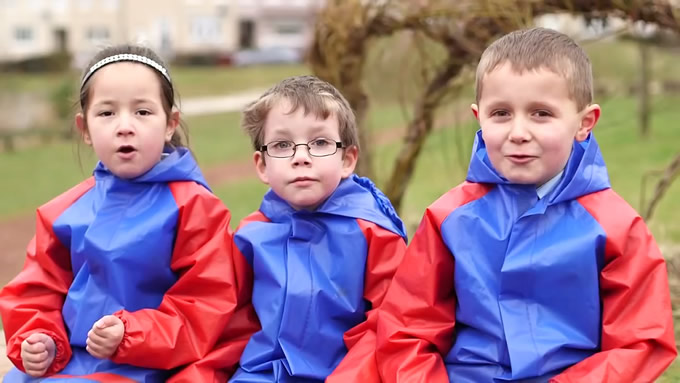
Jackie stressed: “These are not Gaelic Medium Education pupils. They are Gaelic learners in primary one and two. I think that’s really important; it would be so easy to look at them and think that they’re Gaelic Medium.” Instead, they had been learning a little of it through the Go! Gaelic programme of classroom resources for Gaelic learners created by Stòrlann.
Stòrlann chief executive Donald W Morrison said it was “a terrific achievement”, adding:
“As I engage with this heartwarming performance, I can only marvel at the power of the word, the wonder of the story, and the excitement of sharing a common experience. I am not alone, it seems that over two million others have joined with the children of Caledonia Primary as they swish and swash their way through an intrepid Gaelic quest for this big, elusive, bear.
“Stòrlann is extremely proud to have played its part in the facilitation of this remarkable and epic Gaelic adventure.”
Alison Motion, Grounds for Learning Scotland director, said: “It has dwarfed anything else that we have ever put out. On any media. We went looking to see why it had been picked up – and it appears that a children’s programme in the States either made some reference or added it to the ‘you might like to watch this now’ buttons at the side of their website. When something is picked up like that, particularly in different nations, You Tube promotes it and it is more likely to appear on feeds. We did have one very entertaining day watching the view numbers rack up.”
The idea of using the school grounds as the setting had come from the children themselves. It was filmed on a freezing cold day in January and the school janitor had to pour boiling water onto the hard ground to ‘melt’ it so the children would have some mud to splosh around in.
They needed a river, too, and a piece of blue fabric did that job. The best prop has to be the bear, though — the school’s teddy bear mascot, ‘Cal’.
Jackie said: “He was very happy to cooperate and be a scary bear in the concrete tunnel.”
Head teacher Shona Allen said of the film: “We’re really proud of it and we’re so excited when we hear about more views on YouTube.
“It was such a good time for us because Grounds For Learning were using us and Jackie was really promoting Gaelic. It’s a lovely piece of our history; something that’s just had ripple effects.
“I just think it’s brilliant. I’m not surprised (at the number of views) because it was so well done.”
She added: “The children still watch it. Sometimes we put it on in assembly — the P6 and P7 children who were in it still love watching it and they can still recite all of it.”
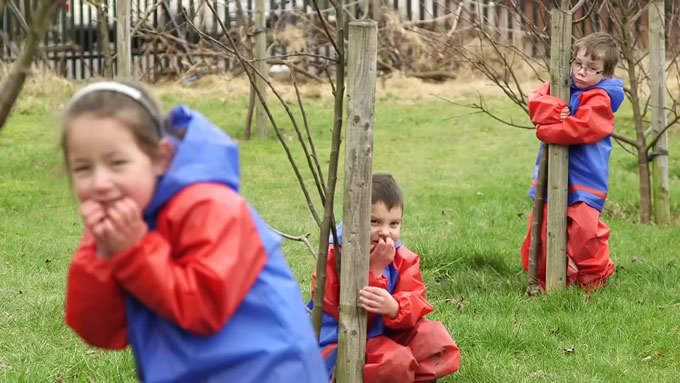
Grounds For Learning said their closest second to this film, which currently has 2.179 million views, is the ‘Natural playgrounds’ film with around 47,000 views.
Director Alison said: “We’re delighted with the success of the Bear Hunt. It’s great to see our Gaelic resource take off in this way. For us the key part of this is that the kids explored outside while doing the poem.
“Outdoor learning is now part of Learning for Sustainability. Children have an entitlement to be outdoors on a daily basis, in nature. There’s plenty of research to show that being outside enhances your mental health and wellbeing.”
14 June 2017
Island teachers ready to Go! Gaelic after pilot training programme
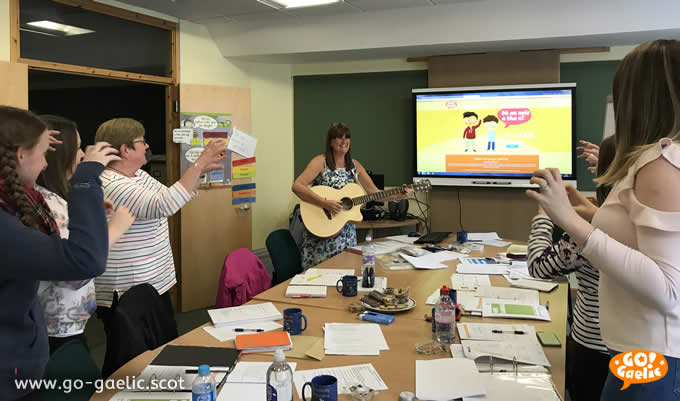
Comhairle praised for commitment to Gaelic in English Medium Education
Seven primary teachers from the Outer Hebrides are about to complete a pilot training course that will enable them to train colleagues in how to teach Gaelic to children in their class.
The programme has been specially constructed by training experts working for Gaelic educational resources organisation Stòrlann Nàiseanta na Gàidhlig as part of the company’s strategic approach to boost the teaching of Gaelic in English Medium Education.
The training demonstrates how to make best use of the Go! Gaelic programme of resources, created by a team of language experts, designers and IT professionals at Stòrlann.
Go! Gaelic has been designed to equip classroom practitioners with the tools to teach Gaelic in learner streams and is an online package of sequenced resources.
As well as having created the resources, the Stòrlann team also work in partnership with local authorities to ensure that training is provided to practitioners who want to learn some Gaelic themselves in order to teach it with confidence.
In Stornoway, seven teachers from the Western Isles began a bespoke training course on May 31 and June 1 and will be completing it this week, on Wednesday and Thursday (June 14 and 15).
This total of four training days on Go! Gaelic is a condensed form of the 18-day Gaelic Language Learning programme, which is usually held in Stirling and open to teachers from local authorities across Scotland.
The Stornoway course, held in the Education Development Centre, is a pilot which recognises that some Western Isles teachers will already be familiar with the language. It was also established to overcome the geographical barriers to accessing training.
The training programme was delivered by Jackie Mullen and planned in conjunction with Yvonne Forrest. They are both Go! Gaelic consultant trainers.
The practitioners who attended the pilot training course came from Stornoway Primary, Sgoil an Rubha, Laxdale Primary, Sgoil nan Loch, Tolsta Primary, Balivanich Primary and Sgoil Uibhist a Tuath. Everyone agreed it had been “really useful” and “inspirational”.
Stòrlann chief executive Donald W Morrison paid tribute to Comhairle nan Eilean Siar for its commitment to Gaelic in all primary schools in the Western Isles.
He said: “Stòrlann congratulates Comhairle nan Eilean Siar on its aim to introduce Gaelic as the second language in all its non-GME schools.
“According to the findings of Scotland’s Census 2011 the Western Isles, despite a decrease in speakers, is the last local authority area on Earth where over half the population (52.3%) possess Gaelic speaking skills.
“Stòrlann’s Go! Gaelic in schools initiative is directly linked to maintaining Gaelic in the area as it mitigates against further attrition of the existing Gaelic speaker base whilst raising awareness of the important place of Gaelic and culture to the multilingual island society in which our young people live, learn and grow.
“Stòrlann is delighted to have the opportunity to work with future trainers and teachers on this exciting Go! Gaelic initiative that will undoubtedly benefit Gaelic in the Western Isles.”
The Go! Gaelic programme can be found online at www.go-gaelic.scot, and there is also a Go! Gaelic App available to complement it.
There are 20 topics within the programme — including introductions, colours, weather and feelings — and the complexity of the language and grammar is sequenced, to build on prior learning.
Delegates at the training course were shown how to navigate the Go! Gaelic website and given practical ideas on how to use the resources, as well as advice on how to pass on this information to colleagues — likely to be during ‘twilight’ after-school sessions or in-service days, although that is yet to be finalised.
One teacher, Katherine Mackinnon from Tolsta Primary, said: “I’ve grown in confidence doing this. It’s really, really useful for people who are feeling slightly less confident in teaching Gaelic.
“I’m looking forward to going out and showing it to other people as well. Jackie’s brilliant, too, and she’s a shining example of how it can be done.
“There is a specific way of going through it systematically. For example, before I was picking out colours from Go! Gaelic but I wasn’t asking myself if the kids had the skills to do that unit. I will have to go and look at it all now.”
Sharon MacKillop, from Sgoil Uibhist a Tuath in Paible, agreed: “There’s a very methodological approach to working through this course.
“I’m a Gaelic learner and I’ve never really got beyond talking about the weather and the date. I feel that, if I follow this myself, I might get over that hump.”
She added: “Jackie is inspirational. Her delivery is fantastic and she’s an example of someone who didn’t have a word of Gaelic herself when she started out. She’s living proof that it can be done, which has probably given me a bit of a push, and if you follow this properly then it should work.”
Speaking afterwards, Jackie said: “When we deliver the course normally, half of it is language acquisition and half is methodology.
“With this group in Stornoway, they are not needing the language so much. They’re needing us to explain how the teachers who don’t have Gaelic will need things broken down for them — because something that seems very simple to them is really complicated to a new learner.”
She added: “The teachers are all very enthusiastic and this really helps. Over the first two days I took them step by step through the first four units and emphasised exactly how to support colleagues who are completely new to the language. I shared with them lots of little tips that have worked for me over and the past few years and they took copious notes throughout.
“We did lots of practical things like games, songs and actions. Their feedback so far has been very positive with all of them saying that they feel they’ve learned loads. Some of them have spoken Gaelic from childhood and I’d wondered how they’d be with an adult learner delivering the course but it’s been fantastic.”
For more information:
Donald W Morrison, Stòrlann — 01851 700880; dwmorrison@storlann.co.uk
Katie Laing, PR — 07825200110; katielaingmedia@gmail.com; katielaing@storlann.co.uk
26 MAY 2017
School shortlisted for Gaelic award praises Stòrlann’s Go! Gaelic programme
Proud finalists: Head teacher Alison McFarlane, back left, and teacher Rachel Neilly with, from left to right, pupils Paige Hamilton, Graham Forrester and Freya Hamilton.
A primary school in North Lanarkshire which teaches Gaelic as its third language is in the running for a top Gaelic education award, alongside schools with Gaelic Medium Education units.
Gartcosh Primary School is up for the Gaelic Award in next month’s Scottish Education Awards, alongside Ardnamurchan High School in Lochaber and Sgoil an Taobh Siar on the Isle of Lewis.
And staff have praised Go! Gaelic, Storlann’s online programme of resources, for enabling them to teach some Gaelic in confidence within ‘mainstream’, or English Medium Education.
Judges from the Education Awards visited Gartcosh recently and class teacher Rachel Neilly, who has been heavily involved in delivering Gaelic within the school, took the opportunity to tell them about the school’s positive experience of using Go! Gaelic.
Go! Gaelic is a vast online suite of sequenced resources designed to support teachers and was created by Stòrlann, the Gaelic educational resources organisation based in Stornoway but with a responsibility to schools teaching Gaelic all over Scotland.
Go! Gaelic does not aim to deliver fluency, unlike Gaelic Medium which is immersive in nature, but is designed as a complete introduction to the language.
The programme, which can be found online at www.go-gaelic.scot, includes a wealth of resources that can be used in the classrooms. There is also a Go! Gaelic App available.
Rachel said: “We mentioned to the judges that we love Go! Gaelic. It’s such a good resource and is really well structured. It’s so good for a learner like myself to be able to access that and have a programme that we absolutely trust because we know that the Gaelic is absolutely accurate.”
Gartcosh Primary teaches Gaelic and German alongside English, in line with Scottish Government policy which states that all children should have the chance to learn an additional language from primary one and a third language thereafter.
At Gartcosh, this means teaching German from primary one and Gaelic officially from primary five — although they try to give the children exposure to both languages from primary one.
Staff have introduced a number of measures in the wider school, outwith actual lessons, to increase the pupils’ familiarity to both languages.
These have included a Gaelic after-school club, a joint Gaelic and German fruit shop and book club, and the use of both languages at assemblies.
Awards are given to the senior pupils who have shown the most enthusiasm for learning Gaelic and for the younger ones who have shown the most interest in Scottish culture.
Another popular feature is the ‘word of the month’ competition, where a pupil gets to nominate a word for Gaelic and German translation and sees it published in the monthly school newsletter.
The school’s main Gaelic event, however, was a Mini Mod, held for the first time last October along similar lines to the traditional festival.
Pupils were involved from primary one and now, inspired by that success, staff are planning a second Mod — but a Gaelic and German one this time, entitled ‘Das Mod’.
It is planned for June 2018 and it is hoped there will also be participation from neighbouring schools. Gartcosh has already had input from Chryston High School’s music department.
In the meantime, the school can look forward to the finals of the Education Awards on June 7 at the Doubletree by Hilton Hotel in Glasgow.
Three pupils will attend the awards alongside head teacher Alison McFarlane and class teacher Rachel Neilly, who has been heavily involved in delivering Gaelic within the school.
Head teacher Alison McFarlane said: “We are delighted to be finalists for the Gaelic category in this year’s Scottish Education Awards. The whole school community is very excited.
“The pupils thoroughly enjoy learning Gaelic as the L3 and are able to display their learning in many ways. We look forward to continuing to learn and use as much Gaelic as possible wherever possible.”
Stòrlann chief executive Donald W Morrison said: “For me, there’s more to this shortlist than meets the eye.
“It highlights the fantastic learning opportunities for learners and fluent speakers from across Scotland and by all accounts it demonstrates the relevance of Gaelic as a language of our day.
“Go! Gaelic gives a big shout out for Gartcosh Primary whose energy and enthusiasm for the language has placed them on the Scottish Education Award podium with finalists from Ardnamurchan and Lewis.”
The Scottish Education Awards are sponsored by the Daily Record and Education Scotland, with the specific Gaelic Education Award being sponsored by Bòrd na Gàidhlig.
The awards “celebrate the hard work and success that takes place in Scottish education” and “recognise the achievements of people who dedicate their lives to children and young people and showcase the valuable work and innovation” in the classroom.
For more information:
Donald W Morrison, Stòrlann — 01851 700880 dwmorrison@storlann.co.uk
Katie Laing, PR — 07825200110 katielaingmedia@gmail.com
08 May 2017
Stòrlann resource package provides additional support for children in GME
An online resource package has been designed to help practitioners support children in Gaelic Medium Education when they need extra help with speech and language.
Stòrlann created the Collective Resource Document by pulling together papers on the subject from a wide variety of experts.
There are a number of papers within the collated document, which can be found on this very site at www.storlann.co.uk/feumalachdan-taic
The document is one of the outcomes of a process that began with an audit on Additional Support Needs (ASN) and staff training in Gaelic Medium Education (GME).
The audit was commissioned by Bòrd na Gàidhlig with funding support from Scottish Government in 2013 and it triggered a series of actions.
First, a multi-agency working group was set up to take forward the recommendations of the audit. Then, a conference was organised in 2014 which heard from a number of specialist speakers on the topic of Additional Support Needs and Speech and Language Therapy in the bilingual context.
This prompted research into the development of new assessment tools in GME and that work is ongoing. It also prompted this collection of papers from experts in various disciplines united by a common interest in the management of Additional Support Needs and Speech and Language Therapy within bilingual education.
The complete Collective Resource Document is available for download as a PDF and is the main resource on the new Feumalachdan-taic (Addiditonal Support Needs) page.
There are also 11 video presentations on the site and the Collective Resource Document itself contains 12 papers.
These include two by the late Archie MacLuillich, a consultant educational psychologist who collaborated with Stòrlann and was a great friend of the organisation. Archie played a key role in the Gaelic ASN initiative.
The primary focus of the Collective Resource Document is on the development of assessment and support tools and methods which take account of the distinctive nature of Gaelic Medium Education.
Its creation also helps to address the point made in Bòrd na Gàidhlig’s Statutory Guidance for Gaelic Education, that “steps should be taken to improve provision for children and young people in GME who require additional support in their learning”.
The resource document includes contributions from speech and language therapists, specialist teachers, psychologists, bilingualism academics and managers of ASN support services in schools.
Stòrlann chief executive Donald Morrison said: “For Stòrlann, this resource represents a first edition that is designed to be updated and added to in the future as the work of resourcing and supporting the Gaelic ASN sector expands and continues.”
He also said: “I wish to highlight the central role that the late Archie MacLullich played in the co-ordination and design of this resource and the wider ASN initiative.
Over many years, Stòrlann enjoyed a long-standing relationship with Archie in his role as advisor and consultant on matters relating to additional support needs — a work that was delivered with enthusiasm and deep insight.”
As well as contributing two chapters, Archie also wrote the foreword to the Collective Resource Document.
In it he said: “The primary focus of the research is on the development of assessment tools and methods — across disciplines and professions — which take account of the distinctive nature of the Gaelic Medium Education context.
"The Resource is a first step in an ongoing process of bringing together theoretical and applied considerations in tackling a resource inequity in the assessment of pupils in Gaelic Medium Education.”
Mona Wilson, Director of Gaelic Education at Bòrd na Gàidhlig, said: “We welcome the publication of these articles. It provides practitioners with the opportunity to access important and useful professional information which can be used to inform their professional practices.”
ends
03/03/17
Àite cudromach do Stòrlann aig co-labhairt nàiseanta air Gàidhlig ann am bun-sgoiltean
Tha pàirt mòr gu bhith aig Stòrlann Nàiseanta na Gàidhlig, am buidheann a tha stèidhte ann an Steòrnabhagh agus a bhios a’ dèanamh ghoireasan do fhoghlam Gàidhlig, ann an co-labhairt nàiseanta Dihaoine 3 Màrt. ’S e amas na co-labhairt leudachadh a thoirt air teagasg na Gàidhlig ann am bun-sgoiltean air feadh Alba.
Tha Co-labhairt Luchd-teagaisg Luchd-ionnsachaidh na Gàidhlig, ann an Sruighlea, ga cumail le Riaghaltas na h-Alba agus ag amas air tidsearan a tha a’ teagasg Gàidhlig ann am Foghlam tro Mheadhan na Beurla.
Thèid a’ phrìomh òraid a dhèanamh le John Swinney, an Leas-phrìomh Mhinistear, a tha cuideachd na Rùnaire Caibineat airson Foghlam agus Sgilean.
Bidh còrr is 80 riochdaire an làthair aig a’ cho-labhairt ann an Taigh-òsta Stirling Court.
Nam measg bidh mu 50 tidsear, agus co-òrdanaichean trèanadh thidsearan, bho air feadh Alba.
Bidh riochdairean ann cuideachd bho Aonad Gàidhlig agus Albais Riaghlatas na h-Alba, cho math ri Foghlam Alba agus Ùghdarrasan Ionadail leithid Siorrachd Lannraig a Tuath agus Comhairle Baile Ghlaschu.
Thuirt John Swinney, an Leas-phrìomh Mhinistear agus Rùnaire a’ Chaibineat airson Foghlam agus Sgilean:
“Tha mi air leth toilichte gu bheil cothrom agam coinneachadh ri luchd-teagaisg aig co-labhairt Luchd-ionnsachaidh na Gàidhlig sa bhun-sgoil.
Le còrr is 50 neach-teagaisg bho 22 Ùghdarras Ionadail an làthair, tha e follaiseach gu bheil ùidh sa Ghàidhlig air feadh Alba.
“Chaidh fìor adhartas a dhèanamh ann an taic is ann an leasachadh na Gàidhlig ann an grunn raointean sna bliadhnaichean mu dheireadh.
Tha seo gu h-àraidh fìor ann am foghlam, sna meadhanan agus sna h-ealain, agus tha sin mar thoradh air buidhnean agus daoine fa leth a rinn obair chruaidh agus oidhirp mhòr.
Tha mi an dòchas gum faigh na bhios an làthair aig a’ cho-labhairt an-diugh buannachd bhon trèanadh agus gun cùm iad a’ neartachadh a’ chànain san àm ri teachd.”
Do Stòrlann, ’s e seo cothrom math aire a tharraing don ghoireas ioma-chuspaireil aca, am prògram Go! Gaelic.
Tha am prògram seo ag amas gu sònraichte air tidsearan agus sgoilearan bun-sgoile ann an sruth luchd-ionnsachaidh na Gàidhlig – chan ann ann am Foghlam tro Mheadhan na Gàidhlig – agus ’s e làn-phasgan a th’ ann a th’ air a dhealbhadh gus tidsearan uidheamachadh gu bhith a’ teagasg beagan Gàidhlig do na sgoilearan aca.
Tha Go! Gaelic air a dhealbhadh gus tidsearan a chuideachadh ann a bhith a’ lìbhrigeadh iomairt Riaghaltas na h-Alba, ‘Ionnsachadh Cànain ann an Alba: Modh-obrach 1+2’.
Tha an iomairt a’ leigeil le clann-sgoile ann an Alba dà chànan ionnsachadh a thuilleadh air a’ chànan mhàthaireil.
Tha 20 aonad air cuspairean sònraichte ann am prògram Go! Gaelic – tha iad rim faicinn aig www.go-gaelic.scot.
Tha mòran ghoireasan ann, agus nam measg taisbeanaidhean PowerPoint, faidhlichean fuaim agus filmichean.
Tha App Go! Gaelic a tha a’ dol an cois a’ phrògram ri fhaighinn cuideachd.
Tha Go! Gaelic a’ faighinn taic bho Riaghaltas na h-Alba, Bòrd na Gàidhlig, agus barrachd is barrachd Ùghdarrasan Ionadail.
Nuair a bhruidhneas e ris a’ cho-labhairt madainn Dihaoine, bidh Dòmhnall MacGilleMhoire, Ceannard Stòrlann, ag innse cho cudromach ’s a tha e teagasg na Gàidhlig ann am bun-sgoiltean a bhrosnachadh.
Canaidh e ris na riochdairean gu bheil Go! Gaelic – ris an do ghabh Comhairle na Gàidhealtachd agus Comhairle nan Eilean mar-thà mar “an dòigh as fheàrr leotha gus Gàidhlig a lìbhrigeadh ann an suidheachadh 1+2 san sgoil” – na ghoireas leis an urrainn dhaibh “tòrr a choileanadh”.
Canaidh e gu bheil Go! Gaelic “a’ toirt taic don amas nàiseanta gun tèid an àireamh de dhaoine òga a tha a’ cleachdadh na Gàidhlig ann an Alba suas,” agus canaidh e cho cudromach ’s a tha e “ann an co-theacsa leasachadh na Gàidhlig ann an Alba”.
An dèidh òraid John Swinney, bidh cothrom aig riochdairean eòlas a chur air a’ ghoireas Go! Gaelic.
An toiseach, seallaidh Dòmhnall Iain MacRisnidh, Ceannard Phròiseactan Stòrlann, an goireas Go! Gaelic dhaibh, agus an uair sin bheir na co-òrdanaichean trèanaidh airson Go! Gaelic na riochdairean tron chiad aonad den chùrsa, gus sealltainn dhaibh mar a tha e ag obair.
An dèidh dha an goireas a shealltainn, faighnichidh Dòmhnall Iain MacRisnidh do na tidsearan dè eile a tha iad ag iarraidh no a’ feumachdainn a thaobh ghoireasan.
“Tha mi a’ dol a dh’iarraidh fios air ais agus chì sinn dè chanas na tidsearan,” thuirt e.
“Tha am fiosrachadh gu lèir a chruinnicheas sinn bhon cho-labhairt luachmhor. ’S e cothrom air leth a tha seo coinneachadh ri uimhir a thidsearan a tha a’ teagasg tro mheadhan na Beurla.”
Katie Laing, PR — 07825200110; katielaingmedia@gmail.com / katielaing@storlann.co.uk
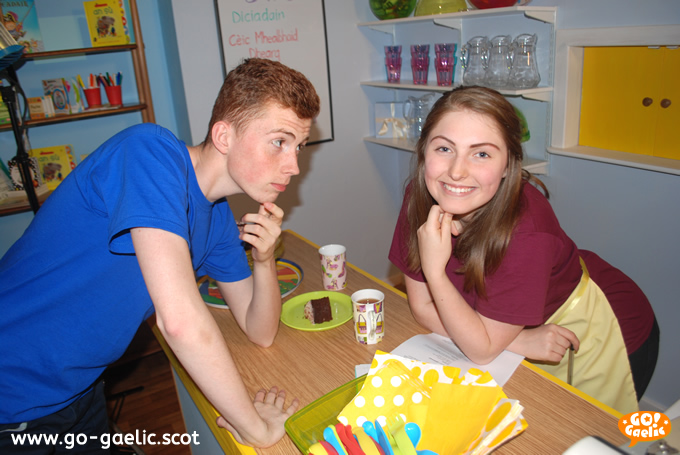
21/02/17
‘Exciting time’ for Gaelic as new phase of teacher training begins
Teachers from the Highlands will be gathering in Plockton tomorrow (Wednesday, February 22) for a training day that marks the beginning of a new phase of Gaelic language learning in primary schools in the region — and indeed Scotland.
Around 25 teachers from 16 schools are expected to take part in this inservice day, being hosted at Plockton High School in Wester Ross.
It is the first training session in an 18-day series to teach them how to use the Go! Gaelic programme of online resources — created by Stòrlann Nàiseanta na Gàidhlig and aimed at enabling primary teachers working in English Medium Education to teach some Gaelic to their classes.
For most of the teachers taking part in the training, the course is also aimed at giving them, personally, enough Gaelic so that they are able to teach it with confidence.
But there will be others attending who already have Gaelic and bespoke workshops are being provided, apparently for the first time, that take account of their existing knowledge and look at ways in which they can help to bring Gaelic out of the lesson and into the general life of the school.
Go! Gaelic is a vast online suite of sequenced resources designed to support teachers and created by Stòrlann, the Gaelic educational resources organisation based in Stornoway (Isle of Lewis) but with a responsibility to schools teaching Gaelic all over Scotland.
Go! Gaelic does not aim to deliver fluency, unlike Gaelic Medium which is immersive in nature, but is designed as a complete introduction to the language. It is expected to appeal to adult learners as well but its main function is to support Gaelic teaching in English Medium primaries.
It has been designed to fit in with the Scottish Government policy Language Learning in Scotland: a 1 + 2 Approach, which is aimed at ensuring every child has the opportunity to learn an additional language from primary one onwards and a third thereafter.
This policy stipulates that, additionally, every child should have the right to learn a second language from primary one onwards — and the policy aims to be implemented across the country by 2020.
As a language course, the structure of Go! Gaelic has been designed to build on previous learning. And, as a child progresses through it, their successive achievements should match up to the formal list of ‘Experiences and Outcomes’ that a teacher will look for under the different stages of Curriculum for Excellence.
The course, which covers 20 topics including introductions, feelings, weather, pets and hobbies, has also been designed to sit well within the Common European Framework of Reference for Languages. This is the Europe-wide guide to language learning, setting out what kinds of topics, words and sentence structure should be taught — and with what increasing difficulty — in order to give a learner the best chance of success.
Go! Gaelic has followed this type of progressive model, for example with the Core Language part of the programme and How the Language Works, which explains grammar features such as sentence structure.
The programme, which can be found online at www.go-gaelic.scot, includes a wealth of resources that can be used in the classrooms, from worksheets and Powerpoint presentations to posters, revision cards, planners and more. It also features audio files – songs as well as vocabulary – plus a series of 20 short films, based on the ‘Cafe Lily’ theme and each one matching one of the topics, to reinforce learning in an entertaining way. There is also a Go! Gaelic App available.
]The use of technology has been seen as key to the success of the programme and is one of the reasons Highland Council adopted Go! Gaelic as their preferred method of delivering the language.
Norma Young is Area Care and Learning Manager for Highland Council with responsibility for Gaelic. She confirmed: “We’ve adopted Go! Gaelic as our preferred means of delivering Gaelic to our teachers to enable them in turn to deliver it on a regular basis to their classes.”
Praising the programme’s “interesting and innovative approach”, she said: “We feel that the resources and the approach are modern, new, exciting and will capture the interest of children because children are much more discerning these days.
“They’ve grown up with IT. Images need to be more interesting, brighter and more colourful because that’s what they’re used to. That’s what Go! Gaelic will give them.
“The language is the same. The acquisition of the language is the same. It’s the delivery that’s much more interactive, attractive and meets the needs of modern technology and the way children learn. Children are no longer passive learners — we want them to interact.”
She added: “This is the first tranche of teachers coming through using this method and we are excited about that. The potential is huge and we’re looking to reach greater numbers of teachers, using this method.
“It’s an exciting time for Gaelic. ‘An t-ionnsachadh òg, an t-ionnsachadh bòidheach’ (young learning is beautiful learning).”
Stòrlann chief executive Donald Morrison said Go! Gaelic “fills the gap” between Gaelic and English Medium Education, providing “pupils outwith Gaelic Medium with the opportunity to engage with Gaelic.”
He said it had been structured to provide the ideal base, should a learner want to progress to fluency. “But even if you don’t become fluent it raises your awareness of the relationship between the language and the people, the culture and the place where you live and that serves to provide you with a better understanding of Scotland in general.”
Funding assistance for Go! Gaelic came from Bòrd na Gàidhlig, the Scottish Government and the Gaelic Language in the Primary School consortium.
Notes for Editors:
This training programme for Go! Gaelic will be split between academic years 2016/17 and 2017/18, with four days training taking place before the summer holidays and the remainder after. It is aimed at teachers with classes from primary one to four. Another Go! Gaelic course will begin in the next academic year, aimed at primary five to seven class teachers. Both courses are aimed at teachers from schools were Gaelic is the official ‘L2’ — the language available to all children in English Medium Education from primary one.
The training is being delivered by Ruairidh Mackay, Gaelic Development Officer 1+2 Languages, Highland Council, and Jackie Mullen, Go! Gaelic consultant trainer for Stòrlann Nàiseanta na Gàidhlig.
This academic session, 2016/17, is the first official year of Go! Gaelic as Highland Council’s preferred methodology and resource package for delivering Gaelic in primary schools outwith Gaelic Medium Education.
The Go! Gaelic programme was launched in September 2015 at the An t-Alltan Gaelic teachers conference and showcased the following month at the Royal National Mod in Oban.
The series of films accompanying the Go! Gaelic programme were launched a year later, at the Gaelic showcase during the Royal National Mod in Stornoway. The films starred and were made by senior pupils from the Nicolson Institute, who had come through Gaelic Medium Education and were, through the films, passing on some of their language skills to new primary school learners.
For more information:
Katie Laing, PR — 07825200110; katielaingmedia@gmail.com / katielaing@storlann.co.uk
29/11/16
A MOTION has been tabled in the Scottish Parliament to congratulate the popular Gaelic4Parents website on its 10th anniversary.
Launched at the Royal National Mod in Dunoon in 2006, the website provides key support for families involved in Gaelic Medium Education (GME) and is run by Gaelic educational resources organisation Stòrlann Nàiseanta Na Gàidhlig.
Angus MacDonald, MSP for Falkirk East and member of the Parliamentary Cross-party group on Gaelic, tabled the motion and said the website provided “an invaluable service to parents and children being taught Gaelic through GME throughout Scotland”.
He also wished “continued success for this fun-filled resource” to the team at Gaelic4Parents and umbrella organisation Stòrlann.
Gaelic4Parents offers a wide range of resources and support to all children and parents with an interest or involvement in Gaelic education but offers vital help, in particular, to those parents who don’t have any Gaelic themselves.
One of its main attractions is the collection of 232 audio books including all the Storyworlds books which get sent home from school for children to read for homework.
There are titles from other ranges too, such as the Gaelic Bookbug scheme, and co-edition ‘hits’, such as Acair’s An Gruffalo.
The other key feature of the website is the official Homework Help section.
This service, supported by Comhairle nan Eilean Siar, is an online chat system where parents can get direct help from a teacher.
It operates during the school term, from Monday to Thursday between 5pm and 7pm, and is manned by two online support workers: Inge Birnie in Aberlour and Anne Marie Henderson in Lewis. It works as a live chat where parents can simply click on the button to ask for help.
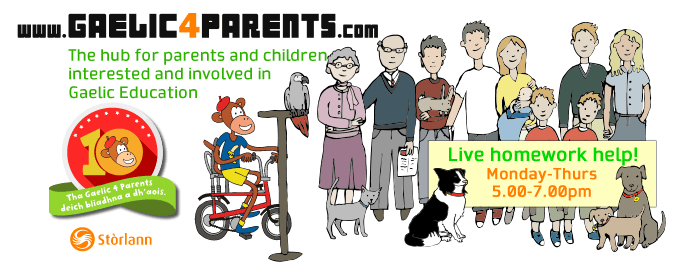
There’s more to Gaelic4Parents.com than just homework help, though. It caters for the early years (0 to 3) up to P7 and features a variety of ways children can learn Gaelic while having fun.
There are songs, pictures to print off and colour in, and games to play, plus the hosting of the Guthan Beaga (Little Voices) section, which teaches parents easy phrases to use with toddlers.
An App is available for Guthan Beaga for iOS and Android, while Gaelic4Parents can be found on Facebook and Twitter @gaelic4parents.
The Facebook page has become a mini community in its own right, with several thousand followers and weekly word list posts that regularly go viral.
The latest word list is on St Andrew’s Day and previously popular ones included Halloween and International Women’s Day, which received around 41,000 and 37,000 views respectively.
Launched in 2010, Gaelic4Parents on Facebook has an average weekly reach of 40,000, and also provides its own informal homework support in that Stòrlann staff who run it will try to answer questions if parents are stuck outwith the live chat time for Homework Help.
It’s all very different from the kind of support that was available in the past. Sarah MacEachan, Project Officer for Stòrlann, has worked on Gaelic4Parents since its inception when the original brief to reproduce a local authority booklet of Gaelic words with English translations was extended to the format of a website.
Sarah said: “Websites are so commonplace now but back in 2006 they were still a relatively new thing. There wasn’t very much ‘online’. Websites were a page with a phone number at the bottom.”
Back then, the website was little more than the Listen and Sing and Listen and Speak sections, plus Guthan Beaga and some pages and bookplates to print off and colour in.
The big step forward came after a few years when Heinemann publishers gave permission for the Storyworlds audio books. “From that point, it pretty much exploded,” said Sarah.
Homework Help followed four years ago and is “without question one of the most useful and highly regarded features that we have on the website.”
Gaelic4Parents is split into sections for different age ranges, with Nip the (Collie) Dog introduced in the early days as the mascot for children aged three to five, while Maoilios (Miles) the Monkey followed a few years later. Maoilios represents the children in primary classes one to four.
Nip and Maoilios are more than happy to come out to events —such as the 10th birthday celebrations held for Gaelic4Parents at the Royal National Mod in Stornoway in October.
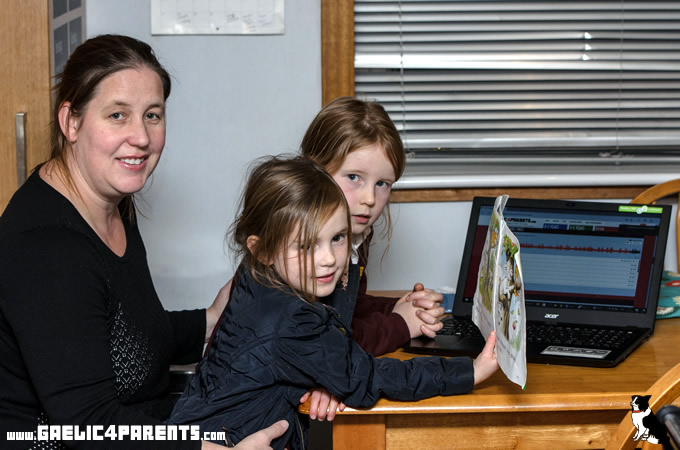
CASE STUDY
Lewis mum Megan Macdonald is among those who decided to put her children into Gaelic Medium Education, despite having no Gaelic herself, because she was reassured by the kind of support offered by Gaelic4Parents.
Megan, who lives just outside Stornoway and is originally from New Zealand, said: “I couldn’t put the girls in Gaelic if it wasn’t for this. It would be impossible because I have no words!
“It’s just brilliant, especially by the time they get to P3 because their words are a wee bit more difficult.”
Megan and husband Donald, who also has no Gaelic, thought seriously about whether they would be able to support Neeve, now seven, and Marley, six, in bilingual education.
“It wasn’t a decision we took lightly,” she said. “I did a lot of research and asked a lot of questions. I thought, ‘Can I manage? Will I be able to do their homework?’”
Megan, who can speak Spanish, was impressed by the researched benefits of bilingual education and finally persuaded when she learned of the help available.
Now it is routine for Megan and the girls, plus one-year-old brother Samuel, to read their homework books at the computer and then play the Gaelic4Parents version.
“I try and get the girls to read the stories themselves and then we listen to it properly.”
Megan has also used the Homework Help live chat — “I typed in a request for translation help and got a reply straight away” — and is reassured about the progress her girls are making. “It’s nice to to have the teachers say, ‘her Gaelic is really, really good’”.
She said: “I find it interesting when I hear people say ‘I can’t put him into Gaelic because I can’t speak it’ because there’s a lot of support. I honestly couldn’t have done it without Gaelic4Parents. I just wouldn’t have been able to entertain it. Sometimes you get a bit jittery about it — but the feedback is that they’re doing alright.”
For more information:
Donald W Morrison, Stòrlann — 01851 700880 dwmorrison@storlann.co.uk
Katie Laing, PR — 07825200110 katielaingmedia@gmail.com
29/11/16
Three Stòrlann projects shortlisted in Scottish Gaelic Awards
Gaelic educational resources organisation Stòrlann Nàiseanta na Gàidhlig have been nominated for three awards in the Daily Record’s Scottish Gaelic Awards, with the finals ceremony being held in Glasgow tomorrow night (Wednesday, Nov 16).
The awards, sponsored by Bòrd na Gàidhlig, are being held in the Grand Central Hotel and aim to “reward all aspects of our Gaelic culture, education and language” and “highlight the excellent work undertaken to maintain growth and heritage”.
Stòrlann have two nominations in the category of Innovation in Education — for learning resources Go! Gaelic and LASADH — and have also been nominated for the Event award for An t-Alltan, the annual conference for teachers in Gaelic Medium Education.
Based in Stornoway, Stòrlann provide Gaelic teaching materials for schools right across Scotland.
Go! Gaelic is a big online package of resources and support for teachers in primary schools who are teaching the language to children outwith Gaelic Medium Education.
The Go! Gaelic programme is highly structured, focusing on 20 key topics and consolidated with the use of multi-media including short films.
These films were launched last month at Mòd nan Eilean Siar and star senior school pupils who have themselves come through GME.
One of the main stars of the films was Katie MacInnnes from Lewis, who has been invited to join Stòrlann representatives at the awards ceremony.
“I’m so very honoured that they’ve asked me to go down,” she said. “It’s so very nice of them. They didn’t have to invite me and I’m very excited to be a part of it.”
She added: “I absolutely loved the filming experience. I hadn’t done anything front of camera before so it was a completely new experience. I loved getting to meet the people that work in Stòrlann. It’s a great, great organisation.”
The other resource nominated in the Innovation in Education category is LASADH, a website for teachers involved in Gaelic Medium Education. Led by two teachers from Skye, Gwen Culbertson and Mairi Macdonald, LASADH is aimed at creating new primary school resources for GME and collating existing ones.
Teachers are welcome, and encouraged, to contribute their own resources to help build a bank of material.
The third nomination is for An t-Alltan, the annual conference for Gaelic teachers and early years staff.
Through a series of talks and workshops over two days, educationalists get the chance to learn about new resources and initiatives.
It is growing every year, with 206 delegates — including three from Canada — attending this year’s event at the Macdonald Aviemore Conference Centre in September.
Maureen McKenna, Executive Director of Education at Glasgow City Council, was one of the speakers this year — and welcomed its nomination.
“This year’s An t-Alltan showed that interest in Gaelic has never been stronger. I was delighted and privileged to be given the opportunity to address the conference and see first hand the level of commitment and extent of engagement in Gaelic language.”
Western Isles MSP Alasdair Allan also welcomed the nominations. “Stòrlann are an essential part of the development of Gaelic medium education throughout Scotland, and are responsible for creating many of the resources on which the sector relies.
“They are a great Hebridean success story, and well worthy of this recognition — meallaibh ur naidheachdan, uile.”
Stòrlann chief executive Donald Morrison said: “We’re highly delighted that we’ve been shortlisted for three projects. It’s great to be among all the other wonderful projects that are listed.”
Stòrlann chairman Robert Dalzell said Go! Gaelic, with its easy accessibility to online sound files and video, had “brought Gaelic teaching into the 21st Century”.
He added that An t-Alltan was going “from strength to strength” and had “become a mainstay for Gaelic teachers seeking professional learning in Gaelic”.
There are nine awards categories, ranging from the Learner Award and Young Gaelic Ambassador Award through to the International Award and Gaelic as an Economic Asset Award. The remaining awards relate to Arts and Culture; Community, Heritage and Tourism; and Best Contribution.
For more information:
Donald W Morrison, Stòrlann — 01851 700880 dwmorrison@storlann.co.uk
Katie Laing, PR — 07825200110 katielaingmedia@gmail.com

18/10/16
GME pupils pass on their skills to learners in primary schools with series of films and songs as part of Go! Gaelic resource
A series of films to help teach Gaelic to children learning it in primary school outwith Gaelic Medium Education is being launched today (October 18) at the Gaelic Showcase at Mòd nan Eilean Siar 2016.
The films star, and were made by, senior school pupils who have come through Gaelic Medium Education and are now passing on their language skills to youngsters who are just beginning to learn it.
The films, made with the support of media professionals, form part of the Go! Gaelic programme, a comprehensive online resource developed by Gaelic educational resources organisation Stòrlann Nàiseanta na Gàidhlig.
There are 20 films in the series, matching the 20 topics in Go! Gaelic, and each of the short films ends with a song.
The films are four minutes long, with drama scripts written by Morag Stewart.
All the melodies were set by popular Lewis singer-songwriter Willie Campbell, and performed by the school pupils themselves.
The new films, complete with songs, will be streamed throughout the day today at the Royal National Mod Showcase in the Nicolson Institute in Stornoway.
Appropriately, it was fifth and sixth year pupils from the Nicolson Institute who were involved in filming for the series, in June, at the An Tosgan studios.
The films form part of the second phase of the Go! Gaelic programme, which was launched last year.
Its 20 topics include introductions, the weather, subjects and hobbies — and while each film contextualises a different topic, they are all set in a cafe being run by a student during the summer holidays.
The films aim to build on learning already been done in class and were carefully written to ensure they only used keywords from the Go! Gaelic programme.
They can be viewed online, at www.go-gaelic.scot, alongside powerpoints and lessons on core language, to help learners get the strongest grasp of key words and phrases.
A Go! Gaelic App has also been developed to complement the programme.
Seven pupils took part altogether, in the making of the films. Three as actors and the rest behind the scenes, with one-to-one support from industry professionals.
Donald MacRitchie, Head of Projects at Stòrlann, said: “These young people were thrown into a professional and intense environment. We couldn’t get over how they handled it. They really did excel. Their attitude towards it all was exemplary.”
Stòrlann also plan to produce a series of books to accompany the films, in order to help support parents with homework. The books, which will be sent home from school, will be condensed versions of the film scripts.
In line with what already happens in Gaelic Medium Education, there will also be audio versions of the books on the Gaelic4Parents website.
Go! Gaelic is primarily aimed at teachers and pupils in Gaelic learning streams and provides training, support and resources to help teach Gaelic to learners across all stages of primary school.
It is designed to help deliver — by giving teachers the necessary resources — the Scottish Government’s initiative Language Learning in Scotland: a 1 + 2 Approach, which stipulates that all children should have the right to learn a second language from primary five onwards.
Stòrlann chief executive Donald Morrison said Go! Gaelic “fills the gap” between Gaelic and English Medium Education, providing “those outwith Gaelic Medium with the opportunity to engage with Gaelic.”
He added: “It’s extremely rewarding to witness current pupils, who have come through Gaelic Medium, passing on their skills to new or future Gaelic speakers.”
“It is a positive demonstration that the investment made towards raising the numbers of Gaelic speakers is coming to fruition. What we have here has the potential to deliver a significant increase in the level of Gaelic awareness and interest and competence amongst young people in schools and homes across Scotland.”
Funding assistance for Go! Gaelic came from Bòrd na Gàidhlig, the Scottish Government and the Gaelic Language in the Primary School consortium. Comhairle nan Eilean Siar assisted with the filmmaking by providing preferential studio rates.
For more information:
Donald W Morrison, Stòrlann — 01851 700880 dwmorrison@storlann.co.uk
Katie Laing, PR — 07825200110 katielaingmedia@gmail.com

